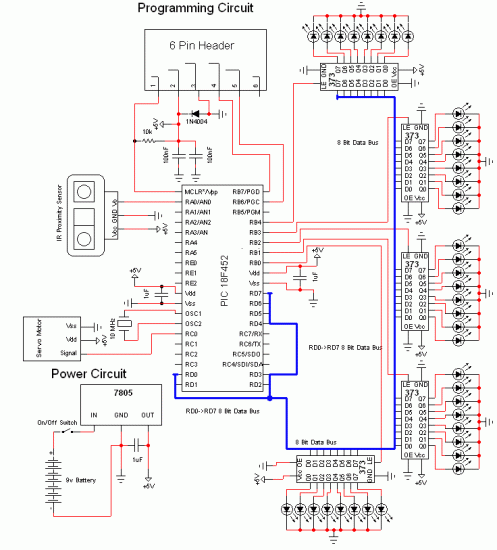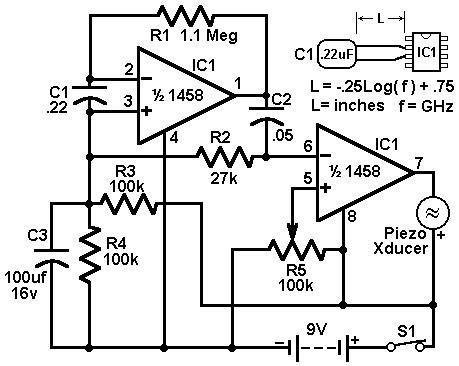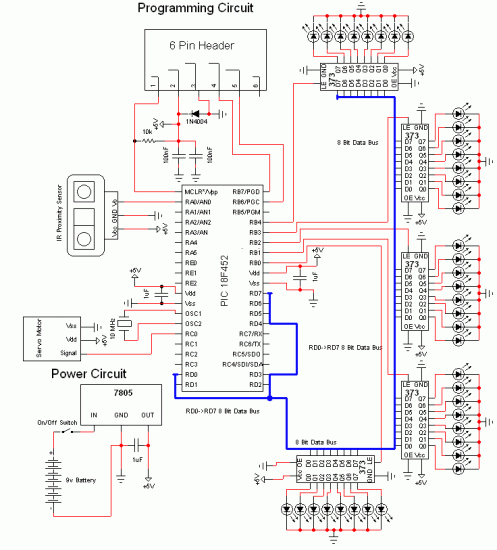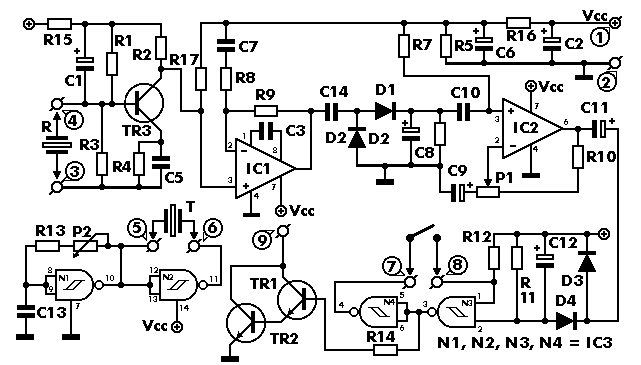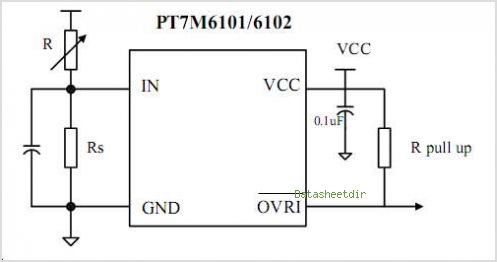
Economy radar detectors
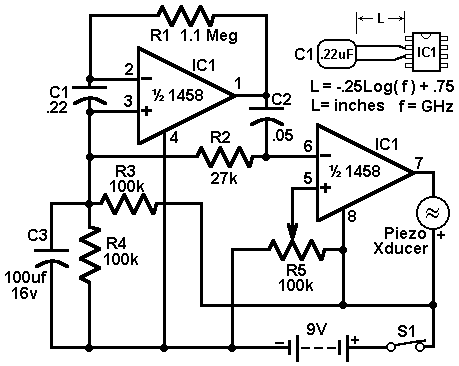
This circuit utilizes a 1458 dual operational amplifier (op-amp) to create a radar detector. Capacitor C1 serves as the radar signal detector. The first op-amp functions as a current-to-voltage converter, while the second op-amp buffers the output to drive a piezo transducer. Resistor R5 determines the switching threshold of the second op-amp; it is typically adjusted to ensure that the circuit only triggers on background noise and is then slightly backed off. The circuit's response can be fine-tuned by adjusting the length of the leads on C1. For standard road-radar systems, the input capacitor's leads should measure approximately 0.5 to 0.6 inches in length.
The described radar detector circuit employs a 1458 dual op-amp, which consists of two independent, high-gain, frequency-compensated op-amps. The design leverages the first op-amp to convert the radar signal detected by capacitor C1 into a voltage signal. This conversion is essential for accurately detecting the presence of radar signals. The output from the first op-amp is then fed into the second op-amp, which acts as a buffer. This buffering is crucial as it isolates the detection circuitry from the load imposed by the piezo transducer, ensuring that the op-amp operates within its optimal range and maintains signal integrity.
Resistor R5 plays a pivotal role in setting the threshold at which the second op-amp activates the piezo transducer. By adjusting R5, the sensitivity of the circuit can be fine-tuned to avoid false triggers from background noise, allowing the detector to respond only to significant radar signals. This adjustment is vital for practical applications, as it enhances the reliability of the radar detection.
The tuning of the circuit's response can also be influenced by the physical characteristics of capacitor C1. Specifically, the length of the leads connected to C1 can affect the circuit's sensitivity and response time. For optimal performance with typical road-radar systems, the recommended lead length of 0.5 to 0.6 inches is critical. This specification is based on empirical testing and ensures that the radar detector performs effectively in real-world scenarios.
Overall, this radar detector circuit exemplifies a balance of simple design and effective performance, making it suitable for various applications where radar detection is necessary.This circuit uses a 1458 dual op-amp to form a radar detector. C1 is the detector of the radar signal. The first op-amp forms a current-to-voltage converter and the second op-amp buffers the output to drive the piezo transducer. R5 sets the switching threshold of the second op-amp; normally it is adjusted so that the circuit barely triggers on bac
kground noise, then it`s backed off a bit. The response of the circuit may be tuned by adjusting the length of the leads on C1. For typical road-radar systems, the input capacitor`s leads should be about 0. 5 to 0. 6 inches long. 🔗 External reference
The described radar detector circuit employs a 1458 dual op-amp, which consists of two independent, high-gain, frequency-compensated op-amps. The design leverages the first op-amp to convert the radar signal detected by capacitor C1 into a voltage signal. This conversion is essential for accurately detecting the presence of radar signals. The output from the first op-amp is then fed into the second op-amp, which acts as a buffer. This buffering is crucial as it isolates the detection circuitry from the load imposed by the piezo transducer, ensuring that the op-amp operates within its optimal range and maintains signal integrity.
Resistor R5 plays a pivotal role in setting the threshold at which the second op-amp activates the piezo transducer. By adjusting R5, the sensitivity of the circuit can be fine-tuned to avoid false triggers from background noise, allowing the detector to respond only to significant radar signals. This adjustment is vital for practical applications, as it enhances the reliability of the radar detection.
The tuning of the circuit's response can also be influenced by the physical characteristics of capacitor C1. Specifically, the length of the leads connected to C1 can affect the circuit's sensitivity and response time. For optimal performance with typical road-radar systems, the recommended lead length of 0.5 to 0.6 inches is critical. This specification is based on empirical testing and ensures that the radar detector performs effectively in real-world scenarios.
Overall, this radar detector circuit exemplifies a balance of simple design and effective performance, making it suitable for various applications where radar detection is necessary.This circuit uses a 1458 dual op-amp to form a radar detector. C1 is the detector of the radar signal. The first op-amp forms a current-to-voltage converter and the second op-amp buffers the output to drive the piezo transducer. R5 sets the switching threshold of the second op-amp; normally it is adjusted so that the circuit barely triggers on bac
kground noise, then it`s backed off a bit. The response of the circuit may be tuned by adjusting the length of the leads on C1. For typical road-radar systems, the input capacitor`s leads should be about 0. 5 to 0. 6 inches long. 🔗 External reference
